3D Printing News Briefs: March 16, 2020
We’ve got news about 3D printers in today’s 3D Printing News Briefs, as BigRrep has shipped its 500th large-format 3D printer. Peopoly is developing new 3D printers for its Phenom series, and startup Excelencia is offering a 3D printing service for large objects. Moving on, MPA, NAMIC, and SSA have launched a Joint Industry Program for 3D printed maritime parts.
BigRep Ships 500th Industrial Large-Format 3D Printer
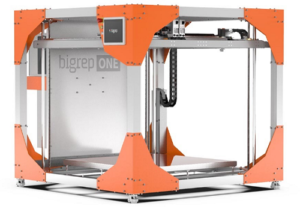 Large-format 3D printing leader BigRep, founded in 2014, just announced that it has shipped its 500th industrial large-format AM system. The company’s managing director, Martin Beck, said that this delivery shows how much all of the company’s industrial customers value BigRep products, which are utilized in a wide variety of applications. The 500th delivery was a BigRep ONE 3D printer, which was shipped to e-mobility tech company JAMADE GERMANY, creator of the AMAZEA underwater scooter – the first water sports mobility device that will use serial produced 3D printed parts at the consumer level.
Large-format 3D printing leader BigRep, founded in 2014, just announced that it has shipped its 500th industrial large-format AM system. The company’s managing director, Martin Beck, said that this delivery shows how much all of the company’s industrial customers value BigRep products, which are utilized in a wide variety of applications. The 500th delivery was a BigRep ONE 3D printer, which was shipped to e-mobility tech company JAMADE GERMANY, creator of the AMAZEA underwater scooter – the first water sports mobility device that will use serial produced 3D printed parts at the consumer level.
“We are very excited about this delivery because it represents a new dimension of industrial AM in end-consumer products, both for us as a company and the industry,” said JAMADE Managing Partner and Technical Director Detlef Klages. “The new BigRep ONE will enable us to launch the serial production of AMAZEA as planned, completing our existing fleet of four BigRep ONE printers. We greatly value the printers’ cost efficiency, accuracy and quality when compared to the extremely high investment for traditional tools.”
Peopoly Developed Two New Phenom Series 3D Printers
 In October, Hong Kong company Peopoly launched its Phenom 3D printer series, which was well-received by industrial users due to a higher resolution print, shorter workflow, and reduced cost. So, using the same MSLA technology, the company, which was founded back in 2016, has developed two new systems for its third generation series: the extra-large Phenom L and the fast Phenom Noir.
In October, Hong Kong company Peopoly launched its Phenom 3D printer series, which was well-received by industrial users due to a higher resolution print, shorter workflow, and reduced cost. So, using the same MSLA technology, the company, which was founded back in 2016, has developed two new systems for its third generation series: the extra-large Phenom L and the fast Phenom Noir.
The Phenom L has a build volume of 345.6 × 194.4 x 400 mm – over 50% larger than the original, which a 20% faster rate of print speed. It also features new build plate designs, which improves the post-processing experience and simplifies the workflow for larger prints. The Phenom Noir has a monochrome LCD panel, designed for enterprise 3D printing applications, that reduces UV light waste, which Peopoly says makes the system run five times faster than the Form 3. With its 293.76 × 165.24 x 400 mm build size, it’s also nearly 13% bigger than the original Phenom.
Excelencia’s Launches 3D Printing Service for Large Objects
Spanish 3D and textile 3D printing distributor Excelencia Tech just launched earlier this month with two big projects. First, the startup is an official distributor for MASSIVIT 3D printers, so it’s focusing on selling these. Secondly, Excelencia is promoting its XL MEDIA Project, which is a service it offers for 3D printing very large objects on its MASSIVIT systems. The 3D printers the startup owns are pretty costly, which is why Excelencia is promoting the use of them to companies that need to print large objects, but can’t afford to purchase their own large-format printer.
“Nowadays, if one of our 3D printings have to be done by a “traditional” 3D printer, it will take couple of weeks and an enormous budget to succed. So we offer the chance to create your 3D products using our machine without buying it, to understand and check all advantatges that Massivit’s machines have,” Miguel Preda Lliso, the Marketing and Business Development Manager for Excelencia, told 3DPrint.com.
“With our technology we can do giant products (about 180 cm) in less tan 48 hours and without generating as much waste as traditional machines (our machines just use as much kilos of material as the product weight).”
Phase 2 of Joint Industry Program for 3D Printed Marine Parts
 Singapore’s National Additive Manufacturing Innovation Cluster (NAMIC), along with SSA and the Maritime and Port Authority of Singapore (MPA), has launched the second phase of a Joint Industry Programme (JIP) for the 3D printing of marine and maritime parts. Phase 1 was completed in October, and Phase 2 consists of the call for proposals from classification societies or AM technology suppliers that would like to participate in the JIP as an industry consortium leader. The objective of this JIP, which has the potential to spin off further developmental projects in the future, is to establish the technical feasibility, regulatory requirements, and commercial viability for creating 3D printed marine parts.
Singapore’s National Additive Manufacturing Innovation Cluster (NAMIC), along with SSA and the Maritime and Port Authority of Singapore (MPA), has launched the second phase of a Joint Industry Programme (JIP) for the 3D printing of marine and maritime parts. Phase 1 was completed in October, and Phase 2 consists of the call for proposals from classification societies or AM technology suppliers that would like to participate in the JIP as an industry consortium leader. The objective of this JIP, which has the potential to spin off further developmental projects in the future, is to establish the technical feasibility, regulatory requirements, and commercial viability for creating 3D printed marine parts.
“Maritime assets are capital intensive, and downtime is costly,” the JIP Challenge Statement reads.
“Replacement of marine spare parts involves many actors in the supply chain, and can be costly in terms of inventory, logistics, and cost of spare parts (especially for obsolete parts).”
The JIP is also working to shine a light on some of the opportunities, and challenges, involved in deploying 3D printing for marine parts, such as approval and certification processes. The application deadline for this phase is 6 pm on April 6, 2020.
Discuss these stories and other 3D printing topics at 3DPrintBoard.com or share your thoughts in the comments below.
The post 3D Printing News Briefs: March 16, 2020 appeared first on 3DPrint.com | The Voice of 3D Printing / Additive Manufacturing.
Singapore initiates Phase 2 of Joint Industry Program to accelerate AM in maritime
3D Printing News Briefs: December 15, 2019
In this edition of 3D Printing News Briefs, it’s business, business, business, and then an upcoming event, 3D Alliances signed a collaboration agreement with Xact Metal. Sigma Labs has appointed a new Executive Chairman to its board of directors. Finally, mark your calendars – NAMIC Summit 2020 is coming to Singapore in May.
3D Alliances Teams Up with Xact Metal, Welcomes Team Member
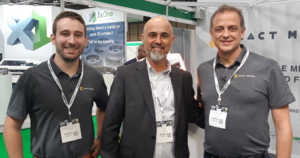 Israeli consulting company 3D Alliances has announced a new collaboration agreement with Pennsylvania startup Xact Metal, which develops metal powder bed fusion systems. 3D Alliances will be supporting Xact Metal as it works to deploy channels and find new sales partners in the Asia Pacific (APAC) region.
Israeli consulting company 3D Alliances has announced a new collaboration agreement with Pennsylvania startup Xact Metal, which develops metal powder bed fusion systems. 3D Alliances will be supporting Xact Metal as it works to deploy channels and find new sales partners in the Asia Pacific (APAC) region.
“No doubt, metal 3D printing solutions are on the rise as professional and industrial users are looking for new solutions that will help them integrate metal technologies in their research and development, prototyping and short run manufacturing processes. Xact Metal answers these exact needs offering professional systems in a very attractive entry point,” stated Gil Lavi, the Founder and CEO of 3D Alliances. “Once the price barrier is no longer a big issue, the acceleration in the adoption of metal systems is inevitable. We look forward working with Xact Metal team bringing it’s great products to the Asia Pacific market.”
But that’s not the only news 3D Alliances is sharing – Scott Hill, a veteran in the 3D printing industry, is joining the company as a senior consultant for North America. This completes its global coverage, as 3D Alliances also has teams in APAC and the DACH region of Europe.
Sigma Labs Names Mark K. Ruport New Executive Chairman
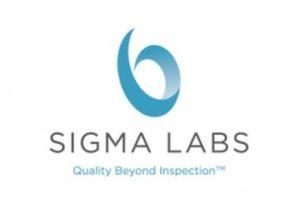 Speaking of new additions, 3D printing quality assurance software developer Sigma Labs has appointed Mark K. Ruport as its executive chairman, and a member of its board of directors. Ruport is an accomplished software executive, with over three decades of experience in both public and private companies, and will work with fellow board member, and the company’s CEO, John Rice to help drive the formation of strategic relationships and sales strategies, increase shareholder value, and speed up growth.
Speaking of new additions, 3D printing quality assurance software developer Sigma Labs has appointed Mark K. Ruport as its executive chairman, and a member of its board of directors. Ruport is an accomplished software executive, with over three decades of experience in both public and private companies, and will work with fellow board member, and the company’s CEO, John Rice to help drive the formation of strategic relationships and sales strategies, increase shareholder value, and speed up growth.
Ruport said, “The ability to have an immediate, tangible impact on Sigma Labs with the apparent adoption of its incredible technology in the marketplace is a unique and exciting opportunity. My focus will be on accelerating our commercial adoption with strategic partners and amplifying the recent success John and his team have achieved. This blueprint is something I am very familiar with given my experience with disruptive companies in the software sector and I look forward to working with the entire team at Sigma Labs to drive forward its strategic initiatives.”
As an inducement award outside of its 2013 Equity Incentive Plan, Sigma Labs granted Ruport non-qualified stock options, in accordance with NASDAQ Listing Rule 5635(c)(4).
Save the Date for NAMIC Summit 2020
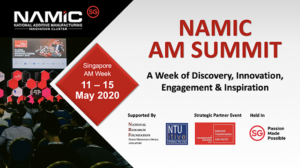 NAMIC (National Additive Manufacturing Innovation Cluster) is hosting its AM Summit 2020 at the Marina Bay Sands EXPO and Convention Centre in Singapore, May 11-15. In addition to a full conference, featuring more than 1,000 local and international delegates and industry leaders, the summit will also include workshops and certification courses, an industry showcase, behind-the-scenes tours at several industry facilities, and the NAMIC Start-up Innovation Forum, held at SGInnovate on the last day of the summit.
NAMIC (National Additive Manufacturing Innovation Cluster) is hosting its AM Summit 2020 at the Marina Bay Sands EXPO and Convention Centre in Singapore, May 11-15. In addition to a full conference, featuring more than 1,000 local and international delegates and industry leaders, the summit will also include workshops and certification courses, an industry showcase, behind-the-scenes tours at several industry facilities, and the NAMIC Start-up Innovation Forum, held at SGInnovate on the last day of the summit.
“Presenting a variety of activities and programmes with the NAMIC Conference anchoring the summit, this will be a unique experience for global 3D printing experts, adopters, innovators and professionals to interact for knowledge sharing and discussions on the latest 3D printing innovations, designs and process development as well as wide-spread industrial adoption,” the NAMIC AM Summit 2020 states on its website.
You can register your interest in attending the latest summit by NAMIC here.
Discuss these stories and other 3D printing topics at 3DPrintBoard.com or share your thoughts in the Facebook comments below.
The post 3D Printing News Briefs: December 15, 2019 appeared first on 3DPrint.com | The Voice of 3D Printing / Additive Manufacturing.
Hamilton Labs, ACG Construction and Saint-Gobain to establish Additive Manufacturing & Robotics Hub
2019 NAMIC Global Additive Manufacturing Summit Day One
Our bellies full of hawker food we walk towards the Singapore Expo. We’re two and two becoming part of NAMIC’s Global Additive Manufacturing Summit a small part of a significant attempt of the candle power heavy nation of Singapore to become a nexus of 3D printing. A few countries are making concerted efforts to concentrate 3D printing within their borders. NAMIC is Singapore’s initiative, as 3DPrint.com we desperately wanted to engage with it because it was so research and application heavy. 3D printing research from Singapore has exploded over the past few years as have a number of very application-specific startups that together make up a core of a Singaporean 3D printing cluster. Additionally, Singapore has also managed to attract the attentions of various 3D printing companies such as Additive Industries, HP, GE with partnerships. The country has also reached out to companies such as Siemens to get them to concentrate their 3D printing efforts here. All in all, it is an irresistible effort that paper by part and MOU by MOU is layer by layer constructing a 3D printing cluster here.

And this is pretty remarkable. Long a technology powerhouse Asia has been a fast follower at best in 3D printing. Our industry is concentrated in Europe and spread out in the states. For long Asian researchers, centers and companies were far and few in between. Until the recent ascendancy of Chinese startups in low-cost FDM, Asia wasn’t really leading in any area of 3D printing. It is optimism bordering on the foolhardy to then place a stake in the ground to try to engineer an industry core here. But this is exactly what NAMIC is doing and so far they’re really making headway. The scene here is vibrant and growing quickly. Out of all the countries that have national initiatives I admire Denmark’s and Singapore’s the most since they’re getting the most bang for their buck and really spending where it counts. In sheer coordination and leveraging the experience of the country in building from nothing I believe the most in the Singaporean initiative over all others.
Also, they have the best food. Post hawker daze, therefore, we sat down to listen to Mahendran Reddy, NAMICs Business Development Director deliver his opening then Dr Ho Chaw Sing, Managing Director, NAMIC welcomed us. The Guest of Honour, Chee Hong Tat, Senior Minister of State, Trade and Industry and Education then spoke, telling us that “Additive Manufacturing will improve lives.”
Larry Lyons Vice President of Product, Desktop Metal then spoke of the company’s journey quoting some incredible print speeds. Sylvia Monsheimer Head of Market Segment N3D, Evonik Germany spoke of high-performance materials while Benjamin Moey Vice President, Additive Manufacturing (Asia Pacific), Siemens wants to design materials for industrial additive manufacturing as well so perhaps they should get together.
Javier Fernandez of Chitonous gave a fascinating presentation on biologically inspired materials. He spoke of biomaterials for “$6 a kilo, the prices of engineering plastics.” Chitionous takes chitosan and other “abundant biomaterials” and takes products such as shrilk which is an artificial insect skin material that can be used by industry. Some of these materials are 3D printable and the company has made 5-meter tall parts out of biomaterials from Singapore. Chitonous’ vision is for local recycling to collect and use biomaterials locally.
Volker Hammes Managing Director BASF New Business GmbH, talked about collaborating on materials fit for purpose. He spoke of BASF’s broad materials portfolio in 3D printing and their willingness to look hard and deep at using in-process waste for new more efficient materials. He also explained that the company was now scoring all new materials on competitiveness and sustainability and will move into more sustainable solutions.
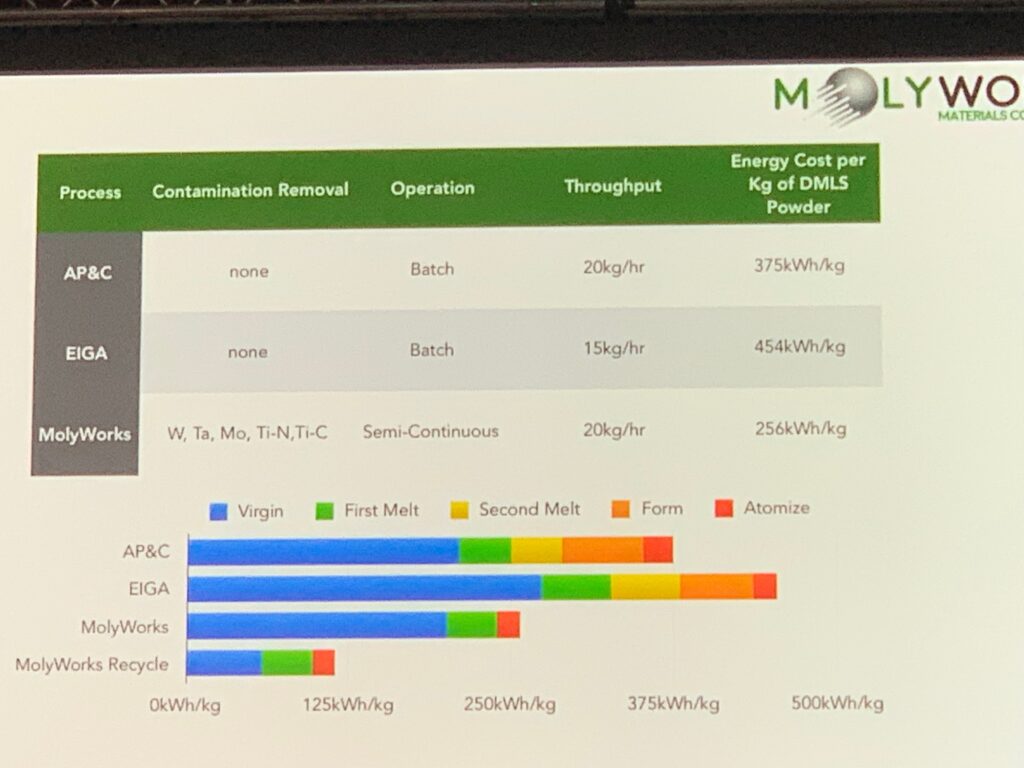
Christopher Eonta the Founder and CEO of the MolyWorks Materials Corporation where he detailed how they were developing a containerized atomization solution that could take a wide array of scrap materials and turn them into 3D printing powder for metal printers. The company has several NSF and US Military grants and is now trying to take $1.40 a pound scrap into $ 95-pound powder and then $1100 a pound aerospace parts. The relatively lower energy costs were very exciting as was the company’s grasp of the value chain.
All in all it was an exciting and thoughtful day and I’m looking for tomorrow.
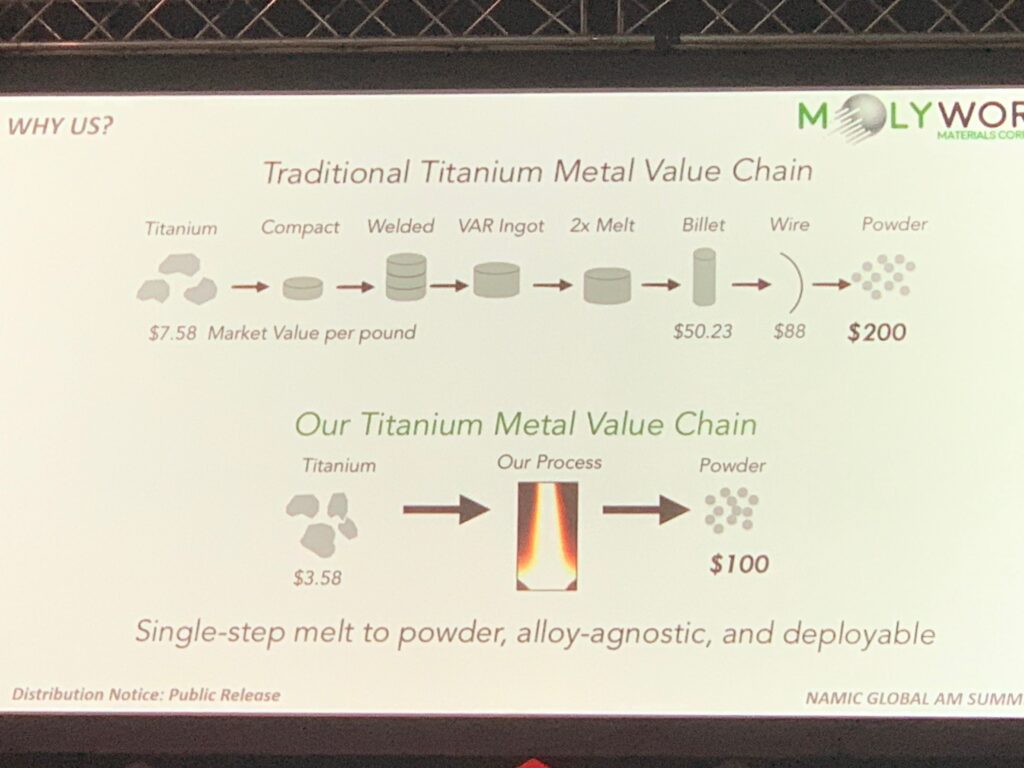
The post 2019 NAMIC Global Additive Manufacturing Summit Day One appeared first on 3DPrint.com | The Voice of 3D Printing / Additive Manufacturing.
3D Printing News Briefs: April 10, 2019
We’ve got some business news for you in today’s 3D Printing News Briefs, before moving on to an upcoming industry event and new materials. 3DVinci Creations and the American University in Dubai will establish a facility for concrete 3D printing, while Telset signed a contract with Relativity. Lincoln Electric has acquired Baker Industries for its 3D printing technology, and Jabil is sharing the results of its survey report on 3D printing. Next month is the NAMIC Summit, with its flagship DfAM event, and Nile Polymers has announced two new PVDF filaments.
Agreement Signed to Establish Center for 3D Concrete Printing
 A cooperation agreement was signed between 3DVinci Creations, the American University in Dubai (AUD), Arabtec Construction Company, and global engineering consultancy firm Robert Bird Group to establish The Center for 3D Concrete Printing and Digital Construction on AUD’s campus. The scientific research center, equipped with a 3DVinci Creations 3D printer, will serve researchers from the university’s three project partners, as well as university students and members of the Faculty of Engineering and Architecture. It will build partnerships, create a consortium of academic, government, and industry entities interested in the growing 3D concrete printing and digital construction fields, work with state officials to promote 3D printing culture in construction, and eventually develop and administer training workshops and seminars on concrete 3D printing.
A cooperation agreement was signed between 3DVinci Creations, the American University in Dubai (AUD), Arabtec Construction Company, and global engineering consultancy firm Robert Bird Group to establish The Center for 3D Concrete Printing and Digital Construction on AUD’s campus. The scientific research center, equipped with a 3DVinci Creations 3D printer, will serve researchers from the university’s three project partners, as well as university students and members of the Faculty of Engineering and Architecture. It will build partnerships, create a consortium of academic, government, and industry entities interested in the growing 3D concrete printing and digital construction fields, work with state officials to promote 3D printing culture in construction, and eventually develop and administer training workshops and seminars on concrete 3D printing.
“With this cooperation agreement, we aim to perform strategic analyses of the present and future capabilities of 3D Concrete Printing and of digitally-driven construction systems. The Center will work with local regulatory bodies to develop newly updated building codes that pertain to 3D printed buildings and structures,” said Edouard Baaklini, CEO of 3DVinci Creations. “We will also develop cost models of 3D Printed Concrete buildings and structures together with tools for value analysis vis-à-vis traditional construction methodologies.”
Relativity Signs Contract with Telesat
 Los Angeles 3D printed rocket manufacturer Relativity just signed its first public, multi-year commercial contract with satellite services vendor Telesat. This is a big deal, as it’s the first agreement between a major satellite operator and a venture-backed “New Space” industry company. It costs about $10 million for Relativity to launch a 1,250 kg payload to low Earth orbit – a price that’s $10 to $20 million less than it would be using a European Ariane rocket or Indian PSLV rocket. The company can keep its costs down by using automation and metal 3D printing in its design and manufacturing processes, and claims its rockets can be made in just 60 days, with far less components. Relativity has completed 136 engine tests and is currently testing its avionics systems, with the first launch of its 3D printed Terran 1 rocket scheduled for the end of 2020.
Los Angeles 3D printed rocket manufacturer Relativity just signed its first public, multi-year commercial contract with satellite services vendor Telesat. This is a big deal, as it’s the first agreement between a major satellite operator and a venture-backed “New Space” industry company. It costs about $10 million for Relativity to launch a 1,250 kg payload to low Earth orbit – a price that’s $10 to $20 million less than it would be using a European Ariane rocket or Indian PSLV rocket. The company can keep its costs down by using automation and metal 3D printing in its design and manufacturing processes, and claims its rockets can be made in just 60 days, with far less components. Relativity has completed 136 engine tests and is currently testing its avionics systems, with the first launch of its 3D printed Terran 1 rocket scheduled for the end of 2020.
“Early in our LEO program we decided that, in addition to working with outstanding leaders in satellite manufacturing and launch services who we know well, Telesat should also include New Space companies whose technologies and manufacturing methods offer lower costs and greater flexibility for deploying our constellation. Relativity is just such a company with their metal 3D printing, use of robotics and other advances,” said Dave Wendling, Telesat’s CTO. “Telesat continues to establish a world-class supplier team to construct, deploy and operate our global LEO network and we are very pleased to welcome Relativity to the Telesat LEO program.”
Lincoln Electric Acquires Baker Industries
 According to a report published last year by SmarTech Industries, the global additive manufacturing market grew 18% to reach $9.3 billion in size, and Lincoln Electric (LECO) wanted a piece of that pie. The company announced that it has acquired Detroit-based Baker Industries, which developed 3D printing tech for the aerospace and automotive industries, for an undisclosed sum as part of a previously announced initiative to expand into the AM industry.
According to a report published last year by SmarTech Industries, the global additive manufacturing market grew 18% to reach $9.3 billion in size, and Lincoln Electric (LECO) wanted a piece of that pie. The company announced that it has acquired Detroit-based Baker Industries, which developed 3D printing tech for the aerospace and automotive industries, for an undisclosed sum as part of a previously announced initiative to expand into the AM industry.
Baker was founded in 1992 to manufacture custom fixtures, parts, and tooling that are Nadcap-accredited, AS9100D-certified, and adhere to the tough aerospace quality management standards. While you can learn more about its services in the video below, Baker primarily offers CNC machining, design, fabrication, prototyping, quality assurance, tooling, and 3D printing services to its customers. With its acquisition of Baker, Lincoln will be able to position itself in the ever growing AM, automation, and tooling sector.
Jabil Shares Results of Survey Report
According to the 2019 Additive Materials and 3D Printing study by Jabil, the practical applications in 3D printing have grown significantly over the last two years. The company surveyed over 300 professionals who are responsible for 3D printing at manufacturing companies, and found that the technology has found its way into almost every step of production, though prototyping still remains the most popular application.
Jabil shared how several key industries, such as medical, transportation, and aerospace, are using the technology today, and reported that 25% of respondents said that 3D printing can be as much as 20 times faster than traditional forms of manufacturing – obviously a major benefit. Jabil itself has adopted the technology at some of its sites because it takes 3D printing very seriously, and believes that the technology “has unlimited potential in the future.” Nearly all of the survey’s respondents said they expected their companies’ 3D printing use to increase over the next two to five years. You can read the full survey report here.
DfAM Conference at NAMIC Summit Coming Up
 Next month in Singapore, the 2019 NAMIC Summit will take place from May 6-10, with its flagship event – the Design for Additive Manufacturing (DfAM) Conference & AM Industry Showcase – happening on May 7th at the Marina Bay Sands Expo & Convention Centre. You can register now for the event to take advantage of early bird rates.
Next month in Singapore, the 2019 NAMIC Summit will take place from May 6-10, with its flagship event – the Design for Additive Manufacturing (DfAM) Conference & AM Industry Showcase – happening on May 7th at the Marina Bay Sands Expo & Convention Centre. You can register now for the event to take advantage of early bird rates.
You can spend the day meeting other like-minded professionals in networking sessions, or take in a presentation by one of over ten distinguished speakers who will be sharing their knowledge about simulation and modeling, industrial applications of digital design solutions, and generative design For example, John Barnes, the founder and managing director of The Barnes Group Advisors, will be speaking about “Design for Manufacturing: The Transformative Role of Design in Driving Innovation in the Future of Manufacturing” at 9:30 am, and the CEO and co-founder of Assembrix Ltd, Lior Polak, will present “Distributed Manufacturing in Action: Dynamic Machine Allocation and Real-Time Monitoring at 1:30 pm.
Nile Polymers Introduces New Additions to Fluorinar PVDF Family
 Utah-based Nile Polymers, which offers an industrial-grade PVDF (polyvinylidene fluoride) filament based on Arkema’s Kynar PVDF material, just announced the addition of two new filaments to its Fluorinar PVDF family – Fluorinar-B and Fluorinar-ESD, also built on Arkema’s Kynar. Chemical-resistant Fluorinar filaments differ from other PVDF materials because they don’t have any additional diluents or polymer additives, and they are tough, flexible, high-strength, and offer flame suppression and UV protection qualities. Sample filaments are available for both
Utah-based Nile Polymers, which offers an industrial-grade PVDF (polyvinylidene fluoride) filament based on Arkema’s Kynar PVDF material, just announced the addition of two new filaments to its Fluorinar PVDF family – Fluorinar-B and Fluorinar-ESD, also built on Arkema’s Kynar. Chemical-resistant Fluorinar filaments differ from other PVDF materials because they don’t have any additional diluents or polymer additives, and they are tough, flexible, high-strength, and offer flame suppression and UV protection qualities. Sample filaments are available for both
Black-colored Fluorinar-B combines the company’s Fluorosmooth adhesive, which increases the surface energy of a print at its interface with a glass build plate, with the dependability of Kynar PVDF, and carbon pigment increases the part’s tensile strength and permeation resistance as well. Graphene-enhanced electrostatic dissipation (ESD) filament Fluorinar-ESD is perfect for applications that have parts which can’t tolerate static build-up, and calibrates impact strength and melt viscosity carefully so the final part is durable and strong.
Discuss these stories and other 3D printing topics at 3DPrintBoard.com or share your thoughts below.
Dr. Scholl’s join trend for custom 3D printed insoles through Wiiv
NAMIC and Wiivv partner to develop customized 3D printable insoles
ASTM International’s Additive Manufacturing Center of Excellence Welcomes Strategic Partner NAMIC, Announces First Round of Projects
About a year ago, international standards organization ASTM International announced that it would be setting up an Additive Manufacturing Center of Excellence, and began enlisting partners to help launch the center. The most recent partner to be added to the roster is Singapore’s National Additive Manufacturing Innovation Cluster (NAMIC), which will coordinate the center’s R&D and related activities in Asia as well as invest up to $1.5 million in the first two years.
NAMIC’s Managing Director, Dr. Ho Chaw Sing, and ASTM International’s Director of Global Additive Manufacturing Programs, Dr. Mohsen Seifi, signed a Strategic Partnership Statement last week at NAMIC’s Global Additive Manufacturing Summit.
“We are excited to enter into this partnership with ASTM International,” said Dr. Sing. “We look forward to catalyzing crucial research that helps establish technical standards, guiding additive manufacturing into the future for Singapore, Asia, and the entire world. Our investment into the center’s regional-based activities will support implementation of additive manufacturing technologies globally.”
 NAMIC is the first organization in Asia to join with ASTM, and its role will be to support R&D and standardization activities that will help drive commercialization of additive manufacturing technologies in sectors such as aerospace, maritime and offshore, logistics and fabrication.
NAMIC is the first organization in Asia to join with ASTM, and its role will be to support R&D and standardization activities that will help drive commercialization of additive manufacturing technologies in sectors such as aerospace, maritime and offshore, logistics and fabrication.
“We are thrilled that NAMIC will be leading the Asia-Pacific’s efforts to drive advancements and innovation in additive manufacturing on a global scale,” said Dr. Seifi. “NAMIC’s leadership in aerospace maintenance, repair, and overhaul, maritime and offshore, and other industries will complement the center’s capabilities, and we are pleased to welcome additional investments in this world-class partnership which will accelerate standardization in this fast-growing field.”
The center’s founding partners are Auburn University, NASA, manufacturing technology innovator EWI, and the UK-based Manufacturing Technology Centre. NAMIC and the US National Institute for Aviation Research (NIAR) are the first two strategic partners.
Recently, ASTM International also announced its first round of funding to support research that will help advance the development of standards for additive manufacturing. The investment of $300,000 as well as in-kind contributions will help the Center of Excellence partners to address technical information needs.
“We are very fortunate to work with such renowned organizations to leverage their expertise towards standardization in additive manufacturing,” said Oerlikon engineer Matthew Donovan, who chairs the research and innovation group under ASTM International’s additive manufacturing technology committee (F42).
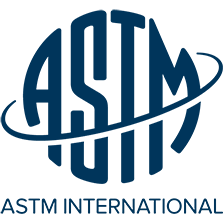 The initial round of projects approved by the committee involve four areas: feedstock, process qualification, post-processing and testing. The Manufacturing Technology Centre (MTC) will research the development of quality assessment standards for metal powders used for additive manufacturing. The research will contribute to a standard guide for evaluating powder quality and recyclability.
The initial round of projects approved by the committee involve four areas: feedstock, process qualification, post-processing and testing. The Manufacturing Technology Centre (MTC) will research the development of quality assessment standards for metal powders used for additive manufacturing. The research will contribute to a standard guide for evaluating powder quality and recyclability.
NASA will work on developing standard procedures, metrics and requirements to help qualify machines and processes for laser bed fusion, while EWI will research how various surface finishing techniques for additively manufactured products impact performance and structural integrity. This will help standardize surface quality and measurement metrics.
Auburn University will research mechanical testing issues in additive manufacturing to better understand the relationships between the properties of test specimens and the performance of parts. This will contribute to a standard that provides guidance on designing test samples that best represent additively manufactured components. Meanwhile, NIAR will focus on mechanical testing issues surrounding polymers used in 3D printing.
You can learn more about the Additive Manufacturing Center of Excellence here.
Discuss this and other 3D printing topics at 3DPrintBoard.com or share your thoughts below.



